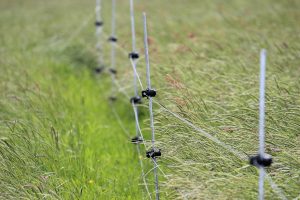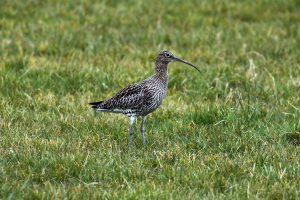Heather Scott, a placement student gaining work experience as part of a Harper Adams University Countryside Management Course spent some time with Tony Cross, ornithologist and Amanda Perkins, project manager on Monday 15th May. She has written a piece about her experience.
We started out from the office at about mid-day as Mandi had to catch up on urgent paperwork.
As we approached the farm where we were meeting Tony, we could see his car. Before we reached Tony the farmer came along and asked Mandi if she and Tony would like to represent the project at a farming event.

Much of the nest finding work is done sitting in the car using binoculars or a telescope, as the car acts as a hide and does not alert the birds to danger in the same way that seeing a person out walking would. The farm we were at has four pairs of territorial curlew on it. Three pairs had already nested, but unfortunately the nests had failed due to crow predation.
Electric fences had been put up around the nests that had eggs and another fence had been put up around a possible nesting site for a pair of birds that had not quite settled, to protect the possible nest site from silage making activity. The birds with failed nests were starting to create second nests. Tony had been watching one of the pairs and we tried to find the nest by walking slowly and carefully in the field where Tony had seen a bird sitting for some time, but we were unsuccessful. The pressure was on as the farmer was soon to put stock back on the field containing the suspected nesting site. We watched another potential nest site, to no avail.
Tony and Mandi had been on the same farm on the day before (Sunday) and on several other occasions. They talked about seeing Yellow Wagtails, Yellowhammers and Reed Buntings. Lots of skylarks were singing and landing in the grassland and we could also see hares crouched down, flattening their ears and hoping not be seen. Tony was fed up at the number of crows about and then Mandi got cross about a low flying helicopter that hovered over a former nest site and close to the new fenced one then over another for a prolonged period of time.
She later reported that when she had spoken with the farmer who was maintaining boundaries with a team of workers and that they had all seemed amused that she had got a bit agitated about the helicopter as she had been gesticulating at it to go away. Over the last two years of nest monitoring, a nest on this farm has been abandoned each year and the common factor on each occasion has been a low flying helicopter over the field.
Tony and I moved onto another site and Mandi went off to buy some additional fence batteries and something to test electric fences with to see if they are working. Tony and I could not find either of the two pairs of birds at the next farm we went to and moved on again. Mandi joined us and watched a foraging bird as we went to some nearby fields where a pair of curlew had been seen.
We played a curlew recording and walked through the field slowly trying to flush a bird, leaving Mandi at the other end to get a different view of the site. Tony was hoping that the bird would be one of a pair that would then return to defend its territory and give us a clue where the nest was. When we got back to where Mandi had been she had gone. The curlew had not responded to the tape, but something else had drawn it to another field across the road and Mandi had driven off in her car to try and keep sight of it.

Tony and I moved onto another nearby site, leaving Mandi to look for the bird that had flown off. Tony and I quickly saw a bird very close to the car and Tony said that this was very near to a site where birds had nested in previous years.
Eventually another curlew emerged from the grassland and the pair flew off towards ground where they are known to forage. We waited for them to return, but they were in no hurry to do so, nor did they seem agitated by being removed from this site which indicated that there is probably not a nest yet. As curlew are relatively site faithful, Tony suggested that if this pair did nest it was likely to be a second attempt.
Mandi had lost her bird over a dip in the field and it was decided that investigating this bird would be for another day. We needed to check an electric fence and we then went to another farm where a bird has been sitting on a nest for some time. An electric fence had been put up, but the battery needed changing. Tony needed to strim around the bottom of the fence to stop the grass causing the fence to short out and stop working through draining the battery’s energy.
Mandi and I cleared the mown grass away from the strip that Tony had strimmed and Mandi explained that the fence was more of a deterrent against mammalian predators rather than completely proofing against them. When the fence was re-connected we tried the new tester, but it did not work. We had to go back to the old test method – Mandi’s hand and she declared with a small jump that it was working.
It was starting to get late and light was fading. Mandi had to deliver some battery chargers and visit a farmer to get permission to drive on his land to observe birds later in the week, so she took me back to the office from the Stiperstones before she did other jobs on the way home. Tony went to one more site before making his way off to the next nightly ornithological duties in Wales.
The project team two were slightly despondent after their second day of no nest success, but the following day two nests were found on territories where we had observed birds and a further nest was discovered as well. For me it was great to see the Curlew sightings and learn a lot more about the Curlew Country project.
Back to Curlew Country Blog Posts

